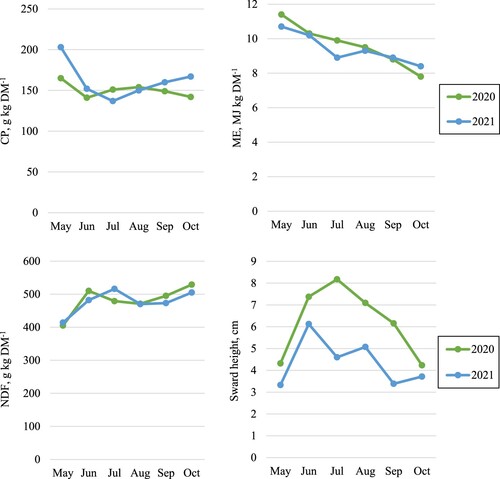Figures & data
Table 1. Proportion (% of dry matter) of grass-clover silage, rolled barley, rolled peas, and cold-pressed rapeseed cake in the total mixed ration fed to dairy × beef heifers at different liveweights in production systems with moderately high (HIGH) or low (LOW) indoor feed intensity (IP = indoor period, IP3 for LOW only).
Table 2. Chemical composition of rolled barley, rolled peas, and cold-pressed rapeseed cake (n = 1) fed to dairy × beef heifers in production systems with moderately high (HIGH) or low (LOW) indoor feed intensity (DM = dry matter, ME = metabolizable energy, CP = crude protein, NDF = neutral detergent fiber).
Table 3. Chemical composition of grass-clover silage fed during indoor period (IP) 1, 2, and 3 to dairy × beef heifers in production systems with moderately high (HIGH) or low (LOW) indoor feed intensity (s.d. = standard deviation, DM = dry matter, ME = metabolizable energy, CP = crude protein, NDF = neutral detergent fiber, NH4-N = ammonium-nitrogen).
Table 4. Feed amounts and areas used to dairy × beef heifers with two sire breeds (Angus (ANG) or Charolais (CHA)) in production systems with moderately high indoor feed intensity and 20 months slaughter age (HIGH) or low indoor feed intensity and 27 months slaughter age (LOW), (DM = dry matter, ha = hectare).
Figure 1. Herbage concentrations of crude protein (CP), metabolizable energy (ME), and neutral detergent fiber (NDF), and sward height in Deschampsia cespitosa-dominated semi-natural grassland grazed from May until October by dairy × beef heifers in production systems with moderately high (HIGH) or low (LOW) feed intensity. 2020 was the first grazing period for heifers in the LOW system, while 2021 was the second grazing period for heifers in the LOW system and the first for heifers in the HIGH system.

Table 5. Daily feed intake (I = intake; DM = dry matter; NDF = neutral detergent fiber), daily liveweight (LW) gain, and feed efficiency (FE; MJ = megajoule metabolizable energy) of dairy × beef heifers (n = 18) with two sire breeds (Angus (ANG) or Charolais (CHA)) in production systems (System) with moderately high indoor feed intensity and 20 months slaughter age (HIGH) or low indoor feed intensity and 27 months slaughter age (LOW). Least square means, pooled standard error of the mean (s.e.), and significance of the main effects of sire breed, production system, and their interaction.
Table 6. Carcass characteristics of dairy × beef heifers (n = 18) with two sire breeds (Angus (ANG) or Charolais (CHA)) in production systems with moderately high indoor feed intensity and 20 months slaughter age (HIGH) or low indoor feed intensity and 27 months slaughter age (LOW). Least square mean, pooled standard error of the mean (s.e.), and significance of the main effects of sire breed, production system, and their interaction.

